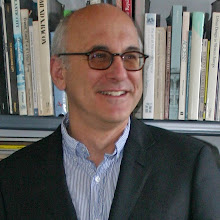 The El Adobe Drive-in Market built in the early 1920's in Hollywood California prefigures today's mini-malls (see Richard Longstreth, The Drive-in, The Supermarket and the Transformation of Commercial Space in Los Angeles, 1914 - 1941)
The El Adobe Drive-in Market built in the early 1920's in Hollywood California prefigures today's mini-malls (see Richard Longstreth, The Drive-in, The Supermarket and the Transformation of Commercial Space in Los Angeles, 1914 - 1941)At the same time economic and social forces reinforce these urban design tenants. In the last years we have heard about location-responsive mortgages that encourage us to build close to transit. Zoning innovations encourage small lot subdivisions and accessory units within formerly single family house neighborhoods Walkability audits lead to improved sidewalks and streets that are green and great. Combined with rising energy costs, together these factors suggest that the city will evolve, finally, towards a New Urbanism.
Facts suggest that these forces are no longer academic. In many cities you can ride a light rail from the airport to the center city to the individual neighborhood and see block after block of mixed-use development rising. Downtowns are being renewed by an agglomerating creative class. People are building smaller houses in the outlying districts. Drivers are selling their SUVs and buying smaller cars. A few are buying Smart cars and then go onto to live the smart urban life. This, if you subscribe religiously to all of the above, may be an urban design challenge you did not anticipate.
 The Smart Car, because it is cheap, efficient and easy to park challenges the viability of a purely traditional urbanism and promotes the building of more mini-malls.Image from smartusa.com.
The Smart Car, because it is cheap, efficient and easy to park challenges the viability of a purely traditional urbanism and promotes the building of more mini-malls.Image from smartusa.com.Smart cars are smart because they dart in and out of congested traffic with ease. They park in the most unlikely of places. They are light and promise great mileage. They project an aura of cool; light, compact, thrifty and convenient. They allow us to ignore and better negotiate the envelope of automobile-oriented sprawl and congestion. Soon, very soon, many more of us will drive micro-cars, save money, and look for places to go; places like light, compact, thrifty and convenient mini-malls.
History suggests that automotive innovation spawns building types and urban forms that belie traditional urbanism. There is no reason to think that micro-cars will not do the same. Los Angeles was one of the first cities in the United States to have a very high percentage of car ownership and it became the place where the 20th Century American landscape of super gas stations, drive-in-markets and supermarkets was more or less invented. While other cities also had their part in this evolution of urbanism, Houston (strip centers), Detroit (interior shopping malls) and Kansas City (auto-villages) come to mind, the forms of automobility spread fastest in Los Angeles (again, see Richard Longstreth). Now, a new generation of automotive innovation will spur a further round of typological evolution. One can easily imagine a hybrid city that is at once compact, traditional, smart and accepting of micro-cars in mini-malls.
If a car is inexpensive to buy, cheap to drive, easy to park and fun to boot, why deny yourself the private pleasures of a mini-car at the mini-center? Micro-cars present one of the greatest challenges to traditional urbanism in the 21rst century precisely because they enable people in urban situations to maintain already dominant patterns of daily existence within spread out urban landscapes. Mini-malls have a natural place within these micro-driven urban environments precisely because they, like the super stations, drive-in markets and supermarkets before them, offer the individual daily convenience through a specific typology with a minimum of fuss, a maximum of freedom and reasonable comfort.
I believe in the compact city. But I also believe that designers will find new ways to make automobile-oriented uses compact. I believe in smart growth. But I also believe that smart cars have a place within the urban intensity that is a consequence of this growth. I believe in sustainability. One response to evolutionary sustainability is buying a very small car that does not use gas nor measure efficiency in terms of miles per gallon. Minicity is the acceptance, sometimes reluctantly, of this already present urban projection and the understanding that architectural visions, indeed new visions for mini-malls, are needed, and will be created.

1 comment:
Love this post!Made me think that if people drove smaller cars,they could actually park them in their narrow driveways, (something noone with an SUV can really do) which potentially provides more opportunities for street parking. Smaller cars might also make the scale of otherwise tight streets (like rosewood btwn fairfax and la brea)) feel a little wider and easier to drive on. Could be nice!
Jamie H
Post a Comment